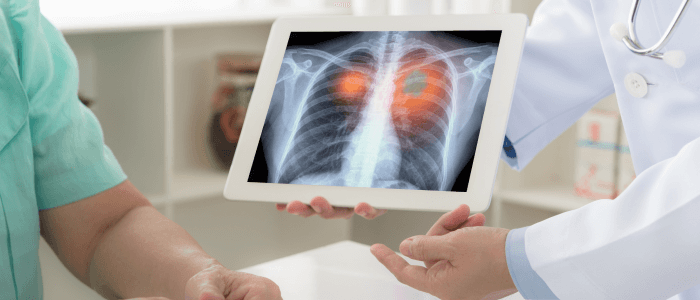
The lungs are the body's most hardworking organs. They expand and contract around 20 times each minute to deliver oxygen to tissues all over the body, and expel carbon dioxide which is generated throughout the body. They are two soft and spongy organs located in the chest that intake oxygen when inhaled and release carbon dioxide when exhaled.
Cancer that initiates in the lungs is known as lung cancer. Cancer in the lungs is common and people who smoke are at the highest risk of developing it. The risk of lung cancer rises with the duration of the smoking period and the number of cigarettes smoked. The silver lining though is that, if one quits this habit even after some years, one can significantly minimize the chances of developing lung cancer.
Cancer Therapy India offers the best lung cancer treatment in India . We have top lung cancer doctors in Bangalore that have the resources and expertise to give you the care you require.
Symptoms of Lung Cancer
Lung cancer mostly doesn't show signs and symptoms in its initial stages. Lung cancer symptoms mostly appear when the disease is advanced.
Signs and symptoms of lung cancer may include:
Having some of these symptoms is not an indication of lung cancer, but if one or more of them persist for more than two weeks or more, then you should see a doctor and an immediate health screening is a must. Consult a lung cancer specialist in Bangalore immediately if you see any related symptoms.
Types of Lung Cancer
The main types of lung cancer are non-small cell and small cell lung cancer. They vary in the size of the cell, as seen under a microscope.
Stages of Lung Cancer
The staging of cancer defines how much it has spread through the body and how dangerous it is. Staging helps healthcare professionals and individuals determine a suitable course of treatment.
The most primary form of staging is as follows:
Similar to this is the TNM staging system. Healthcare professionals assess the tumor for size and spread, whether or not it influences the lymph nodes, and whether or not it has spread somewhere. There are also certain ways of staging non-small cell and small cell lung cancer.
When should one consult a doctor?
One should consult a lung cancer specialist in India if he/she develops the sign or symptoms associated with lung cancer, in particular if they have
Screening of Lung Cancer
Undergoing periodic screening may be the best idea for people with a higher risk of developing lung cancer. Screening is with a small-dose CT scan.
Diagnosing Lung Cancer
Diagnosing lung cancer begins with a conversation with your physician and a physical exam. They’ll want to go through your health history and any symptoms you’re having. You will also need tests to confirm the diagnosis. These tests might include:
A biopsy may also be required. A biopsy is a procedure in which a small sample of lung tissue is taken and examined under a microscope. This procedure can be used to detect whether or not tumor cells are cancerous. A biopsy may be performed using one of the following methods:
If the biopsy results are positive for cancer, you may require additional testing, such as a bone scan, to help determine if cancer has spread and to help with staging.
Treatment of Lung Cancer
Treatment will depend on several factors, including:
All the treatment methods can have adverse effects. A person should speak with their healthcare professional about the most acceptable choice for them, including the pros and cons of each option.
Some treatment options include:
A healthcare surgeon will work with the individual and modify their treatment plan as their needs change.
Lung cancer is a possibly incurable type of cancer, but people who get diagnosed on time often have a better chance of survival. People with a high risk of having lung cancer may wish to consider undergoing constant screening. This can spot the initial signs and allow for treatment before cancer expands. An individual who has concerns about their risk of lung cancer should talk with their best lung surgeon.
Cancer Therapy has a team of lung cancer specialist in Bangalore who have wide experience and strive their best to help lung cancer patients by offering state of art treatment facilities.